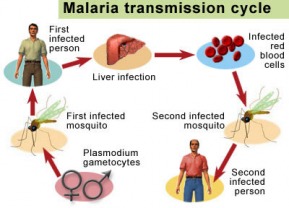What is Malaria? Their Systematic Position. Types of Malaria. Life-Cycle, symptoms and control methods.
What is Malaria?
Malaria is a harmful disease of human beings. It is caused by Plasmodium and transmitted through the bite of the female Anopheles mosquito. In this disease primary host is a man and the secondary or intermediate host is a mosquito.
Species of Plasmodium
There are four species of Plasmodium. Which causes different types of Malaria.
- Plasmodium Vivax
- Plasmodium Ovale
- Plasmodium Malariae
- Plasmodium Falciparum
Systematic Position:-
Phylum – Protozoa
Sub Phylum – Sporozoa
Class – Telospora
Order – Eucoccida
Family – Plasmodiidae
Genus – Plasmodium
Species – Vivax, Ovale, Malariae, Falciparum
Types of Malaria
These are mainly Four types and caused by different species of Plasmodium.
- Tertian Malaria – It is caused by Plasmodium Vivax. In which fever is repeated every third day i.e. after 48 hours. This type of Malaria is not very harmful, in this case death rate is very low. The incidence of this disease is worldwide, in tropical, sub-tropical, and mainly present in temperate regions. The average incubation period of this disease is 14 days.
- Mild Tertian or Ovale Malaria – It is caused by P. Ovale. In which fever is repeated every third day or interval of 48 hours. It resembles tertian malaria. It is not greatly harmful and is mainly confined in the African region.
- Quartan Malaria – It is caused by P. Malariae. This fever is repeated every fourth day or interval of 72 hours. This disease is worldwide in occurrence, in tropical, subtropical, and temperate regions is mainly found. It is a quartan severe disease.
- Malignant Tertian or Pernicious Malaria – It is caused by P. Falciparum. In this disease, fever is repeated every third day i.e. after 36-48 hours. In this case, it affects the brain, and the death or fatal rate is very high. It is distributed in the world, in tropical, subtropical, and warmer temperate zones.
The above four types are main but in some cases, one another type also occurs. Which is called Quotidian Malaria.
- Quotidian Malaria – In this case, more than one species of Plasmodium bites the human being and infected them. In this condition, fever is repeated every day.
Life-Cycle of Plasmodium
The Life Cycle of Plasmodium is completed in two hosts. The primary or definite host is a man and the intermediate or secondary host is a mosquito.

- Man – The parasite is intracellular in man. The asexual cycle is completed in two forms. 1. Liver Schizogony, 2. Erythrocytic Schizogony and Gametocyte are formed at the end.
- Mosquito – The parasite is extracellular in mosquitoes. The sexual cycle is completed in two forms – 1. Gamogony and 2. Sporogony. The sporogony helps in the formation of infectious sporozoite individuals.
Inoculation or Infection
The parasite is introduced into the human bloodstream through the bite of a female Anopheles mosquito. The parasite bites the human for sucking blood. The parasite entering the blood is first carried to the liver, where it multiplies by pre-erythrocytic schizogony and after a few cycles appear in the blood.
Pathogenesis
Plasmodium attacks on the RBC. The parasite’s feed lives and multiplies inside them. After the completion of each cycle, these release toxic substance hemozoin. It causes shivering and high fever.
Malaria is identified by the periodic attacks of high fever. The death of man is not actually directly due to the parasite but the parasite makes the patient weak causing anemia ultimately resulting in death.
Additional Symptoms
- Destruction of erythrocyte on the liberation of malaria.
- Infected erythrocyte becomes more fragile, rupture easily, and are destroyed.
- The enlarged spleen due to malaria infection releases the toxic substances lysolecithin which destroys erythrocytes.
- This parasite produces hemolysin (an antibody) Which bring about hemolysis of some normal erythrocyte.
- Falciparum infection often results in thrombosis of visceral capillaries. Death is caused when the capillaries of the brain are congested.
Which kind of People has a higher risk from Malaria?
Some population groups are at considerably higher risk of contracting malaria and developing severe disease, than others. These include infants, children under 5 years of age, pregnant women, and patients with HIV/ AIDS, as well as non-immune migrants, mobile population, and travelers. National malaria control programs need to take special measures to protect these population groups from this infection, taking into consideration their specific circumstances.
Prevention and Control of Malaria
- The use of mosquito nets may protect human beings from the bite of mosquitoes.
- Use effective insecticide to kill the adult mosquito.
- Elimination of Anopheles breeding ground.
- The use of repellents (anti-mosquito cream) on the exposed part of the body may protect man from mosquito bites for a few hours.
- Introduce larvicidal Fishes like Gambusia and Mino in fountains, lakes, ponds, tanks, etc. They feed upon mosquito larvae and pupae.


